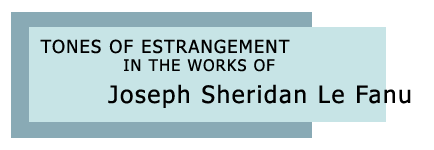Landscape
1) How is the landscape described?
2) Does the landscape support a nationalist reading?
(keywords : the invocation of the sublime, specific locations, the presence of unique landmarks or flora and fauna, references to past events taking place
in that landscape)
3) What is the nature of the relationship between protagonists and landscape?
(keywords : the superimposing of protagonists' thoughts and feelings on the appearance of the landscape, the history of the protagonist with and within
the landscape)
4) Does the landscape alter appearance or nature as the story unfolds?
(keywords : developments in plot and character)
5) Does the relationship between protagonists and the landscape alter as the story unfolds?
(keywords : developments in plot and character)
Folklore and Mythology
1) What is the role of folklore and/or mythology in the text?
(keywords : at the root of the plot, as background tapestry to or components supporting e.g. the plot and mood of a gothic novel, as serving a purpose
other than or in addition to the record of the folklore and/or mythology e.g. nationalist)
2) How are mythology, folklore and folkloric traditions perceived and presented in the text?
(keywords : negative, positive, true, false)
3) Does the text serve as a record of folk traditions or does it primarily derive inspiration from them?
(keywords : integrity to the original traditions, a further development of or variation on the original traditions)
4) Are the folkloric and/or mythological elements to be taken literally or symbolically?
"The Ghost and the Bonesetter"
1) What is the attitude of the general editor of "The Purcell Papers" to the folkloric elements in the text?
2) What is Father Purcell's attitude to the folkloric elements in the text?
3) What is the bonesetter's son's attitude to the superstitions in the text?
4) What is the role of superstition and folk tradition in the text and in what light is it generally presented?
5) How credible is the bonesetter's son and his tale, and how does this reflect on the general representation of folk tradition and superstition in the text?
6) Where does estrangement make itself known in the text?
7) Does this text afford a nationalist reading?
8) How is this text a record of folk tradition?
"The Ghost and the Bonesetter" is available as e-text at
[ this url address ]
"Laura Silver Bell"
1) Who or what represents the folklore traditions in this text?
2) What role do the faeries play in this text?
3) Why is Laura oblivious to the danger she is in?
4) What is the role of Mall Clarke and Laura's father in the text? How do they fulfill that role?
5) There is an added dimension to the role of landscape in this text – What is it?
6) Where does estrangement make itself known in the text?
7) Compare "Laura Silver Bell" to the "The Child that went with Faeries"
"Laura Silver Bell" is available as e-text at
[ this url address ]
"Green Tea"
1) How does the haunted clergyman interpret and deal with his situation?
2) What is Dr.Hesselius' diagnosis?
3) When did the spectral monkey first appear?
4) What are the triggers, if any, which call forth the spectral monkey?
5) Supposing that the clergyman is not haunted, but is projecting the horror through his own imagination, what may lie at the
root of this self-torment?
6) Le Fanu himself drank large quantities of green tea, had a fascination of the occult and suffered from religious doubt – How does that figure in an
interpretation and reflect on Dr.Hesselius' diagnosis?
7) Is the supernatural denied or confirmed in the text?
8) Where does estrangement make itself known in the text?
"Stories of Lough Guir"
1) How is the folkloric tradition portrayed in these tales? Does it suggest a longstanding tradition and, if so, how?
2) How are these texts a record of folk traditions?
3) What is the purpose of the references to local culture and daily life?
4) What is the role of landscape in these tales?
5) What are the gothic elements in these tales and what effect do they have?
6) How does the past figure in these tales?
7) Consider the language used in the telling – Does it convey and support the folk tradition? Do we more readlity believe the tales by the way they are
told, and, if so, why?
8) How do these tales enforce a sense of cultural identity?
"Stories of Lough Guir" is available as e-text at
[ this url address ]


